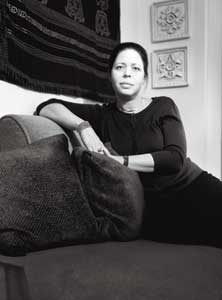 The art of healing The art of healing
Ani Buk's troubled patients find peace of mind through drawing, painting, and sculpting.
by Elaine McArdle
photographs by John Rae
The young couple were recent immigrants from West Africa, relishing their new life in New York City, expecting their first child, and happily sharing in the American Dream. One Friday afternoon, a month before the baby was due, the woman was home alone and answered a knock at the door. A man dressed as a postal worker asked her to sign for a package from her homeland. Moments later, a phalanx of undercover police officers burst into the apartment with guns drawn. Arrested on drug charges, she was thrown in a cell with drug abusers and prostitutes and denied the requisite phone call to arrange for help.
Her husband spent a frantic weekend searching for her. When he finally found her, on Sunday evening, the couple learned that drug-sniffing dogs at customs had reacted to the package, which police then delivered in a sting operation.
It turned out the package contained harmless herbs sent by an African midwife to aid the woman's pregnancy. The charges against her were dropped, but the emotional trauma of a weekend in jail wouldn't fade so easily.
When the woman arrived at the outpatient mental-health clinic where Ani Stern Buk, J79, was working, she had full-blown post-traumatic stress disorder and tremendous difficulty talking about the experience. So Buk, a nationally recognized expert in art therapy for trauma survivors, offered a box of colored pencils, and the woman began to draw. Over the next year, the woman returned weekly. Each time, with Buk's gentle encouragement, she drew pictures—of a frightened woman,
of the jail cell, and, finally, when she felt safe enough, of her secret fantasies of retribution against the police who had disrupted her life, fantasies about which she had felt much shame because she thought they meant she herself was a criminal.
While the act of creating art was therapeutic in itself, it also enabled the woman to open up verbally and express her outrage and sadness over what had happened. But the art had another critical function. Buried within the drawings were clues to something the woman didn't consciously remember, an event that came to light only later, through a police report used as evidence during her successful lawsuit against the City of New York. After the officers had handcuffed the woman in her apartment, the report noted, a female officer had conducted a vaginal search. The woman had no conscious recollection of the event, which could have endangered her unborn child, but, according to Buk, her unconscious sought to express itself in her drawings.
 |
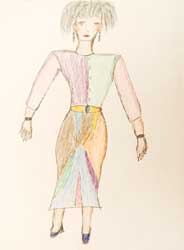 |
"It's here, in the very first picture," says Buk, who on a spring afternoon sits in her softly lit office on the Upper West Side of Manhattan and points to a drawing of a female figure with a flat, vacant expression.
Like much of the patient artwork Buk uses to train art therapists and other clinicians, this drawing appears unexceptional at first glance—a simple human figure. Then Buk calls attention to the sharp, swordlike designs on the figure's skirt, which point to the woman's genital area. When she first saw the picture, Buk wondered if her patient had been sexually abused, a suspicion that grew as the drawings accumulated. But the woman never mentioned abuse, and Buk didn't push her. Still, Buk wasn't surprised when the truth was revealed at trial.
"When a well-trained art therapist gets a visceral sense that something has happened, it's generally based on something we're perceiving, even if it's subliminal," says Buk, who has a warm, open face, large eyes, and long dark hair she wears in a low ponytail. "The artist is expressing an experience in a multimodal fashion, and we are tracking it because of our fluency in emotional expression and the art-making process."
Buk, who is also a psychoanalyst, emphasizes that art therapists must be careful both in interpreting art and in discussing it with patients, who may literally be unable to access or verbalize certain emotions and memories. "A lot of the work that art therapists do is helping people connect with a safe place inside themselves that no trauma can touch," she says. "That's the part that has allowed them to survive and keep moving through the world despite what has happened."
Over the past 18 years, Buk has treated more than a thousand severely traumatized patients: victims of war and torture, survivors of sexual and physical abuse, children whose parents died in the terrorist attacks of 9/11. Her work
has been the subject of television news reports and articles in the New York Times, U.S. News & World Report, and the Chicago Tribune, and she has had hundreds of speaking engagements. She teaches in the Graduate Art Therapy Program at New York University. In what is a rare distinction for an art therapist, Buk is also on the psychiatry faculty of a medical school, the Albert Einstein College of Medicine in New York. She has trained numerous primary-care residents, as well as physicians and psychotherapists who volunteer with the humanitarian organization Doctors of the World, in how to evaluate the psychological scars of those seeking political asylum.
Through training others as well as her own work with patients, Buk daily experiences the redemptive power of psychotherapy. "To me, it's such an honor to be able to participate in people's efforts to give themselves a different quality of life," she says.
Converging paths
Buk's passion about her work belies the circuitous route it took to get there—a route that, in the end, merged two disciplines that had always intrigued her.
As a high school student in Connecticut and New York, Buk was drawn to psychology and art and took courses in both. She enrolled at Tufts in the footsteps of her father, Harold Stern, A48, M52, a thoracic and vascular surgeon. Although she continued to study art, she majored in mental health, an innovative program that offered undergraduates practical training in clinical psychology. "The hands-on approach interested me, as opposed to a theoretical or research approach, which most undergraduate schools offered at the time," she says. Part of her training consisted of a rigorous internship at a school for emotionally disturbed adolescents.
During her junior year, she went to the Athenian Institute of Anthropos, a psychology training center in Greece, to study how culture influences mind, perception, and emotion. It was her Tufts professors who inspired her to take on such thorny questions, she says. "I think their belief in us as clinicians-in-training gave us the confidence to consider the complexity of human behavior, and to take a holistic and humanistic perspective. That really became the bedrock of all my future undertakings."
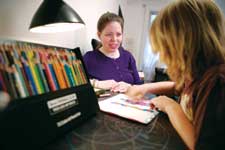 |
 |
After graduating magna cum laude from Tufts, she worked as a counselor on an acute psychiatric inpatient ward of a state hospital in Boston, and planned to go on for a Ph.D. in psychology. But she felt herself being tugged by her love for art. She instead studied graphic design at Yale, where she received prestigious awards and earned a master of fine arts degree in 1985. The following year, as a graphic designer in New York creating posters and brochures for upscale clients, she felt pulled back in the other direction.
"I didn't feel I was really contributing to the world in the way I was used to," she explains. In a catalog for adult education, she spotted a course in art therapy—a discipline that would let her meld her two great passions. "It was one of those eureka moments, when you realize it was what you've been looking for all along."
Art therapy engages the creative processes of drawing, painting, and sculpting to help patients heal from emotional and psychological wounds. For the 4,000 certified art therapists in the United States, the patient's art-making helps uncover what ails the person, including the effects of traumatic events that the person cannot consciously remember or can't verbalize. Although the field of art therapy was established in the 1940s, it took the catastrophic events of September 11, 2001, to bring it to widespread public attention, when art therapists, including Buk, stepped forward to help victims and their families deal with the psychological aftermath. Since then, they have earned an even higher profile through their volunteer efforts after Hurricane Katrina and the Asian tsunami of 2004.
Buk enrolled at New York University in the master's program in art therapy and began her practical training at a rehabilitation center for patients with severe medical trauma such as spinal cord injuries. She then worked at a residential treatment center for physically and sexually abused children, and later became the director of the creative arts therapy department at New York City's North Central Bronx Hospital.
From the start, she recognized the enormous value of art therapy for patients of all ages and with a wide variety of problems. It was, she realized, "an extremely effective form of treatment and also very useful from a diagnostic perspective. It is always so moving to see people connecting with the art-making process, sometimes for the first time in their lives, as they work to heal themselves."
 |
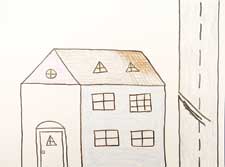 |
One young patient was severely depressed and almost mute after becoming a paraplegic in a fall from her parents' roof the summer before she was to begin college. In her work with Buk, the girl, who insisted she'd accidentally slipped while sunbathing on the roof, drew a detailed picture of the house from a street-level perspective. But one day, she drew a road next to the house—a road seen from a bird's-eye perspective—and then added a slash-like mark across the road. It was at that point that Buk realized the girl had probably leapt from the roof in a failed suicide attempt. "The birds-eye view is what you'd see if you were getting ready to jump, and the road stretches from the bottom of the page up to the top of the page, seeming to indicate a path toward the heavens," explains Buk. "And the slash mark across the road indicates an interruption in what could be seen as a symbol of the path of life." The next day, the girl disclosed to her therapist that she had indeed tried to kill herself. Only after depicting the event pictorially and at her own pace, Buk believes, did the girl feel safe enough to talk about it.
Like any good art therapist, Buk refrains from jumping to conclusions. Instead, she looks for patterns and repeating images that suggest something about the patient's experience. She must take into account the patient's level of skill in using the art materials and, just as important, the degree to which the patient has come to trust the therapist.
Trust was paramount in the case of one seven-year-old boy. He drew a series of pictures, each more strongly suggesting to Buk that he was being abused in some way. They showed such things as basketball hoops with frightening-looking edges that resembled teeth, and giant figures looming over tiny ones. The boy went on to create a sculpture of a head, constructing it so that the top of the head could be lifted off to expose a removable brain. Repeatedly taking the sculpture apart and putting it back together seemed to soothe the boy. "I think he was practicing being able to reveal to me what was on his mind without completely falling apart," says Buk; indeed, he later told her that both of his parents had been sexually abusing him for years. "The vulnerability expressed by that sculpture represents better than any words can what extreme trauma can do to the mind," adds Buk. She routinely shows a slide of the sculpture when teaching clinicians about the psychological impact of trauma.
When words fail
Although art therapy is gaining respect and a higher profile, misperceptions persist. It is not, for example, mainly for children. Art therapy can be valuable for patients of all ages and with a wide variety of complaints, including learning disabilities, substance abuse, and depression. Nor do patients need any particular talent or experience—it's the act of creation, not the end product, that's beneficial. And contrary to what many people believe, art therapy does not lack a scientific foundation. Several journals regularly publish studies bolstering the field's validity.
One favorable scientific avenue is the work of leading researchers in the field of trauma and memory. Buk explains that such research points to the importance of the hippocampus, the part of the brain that links the memory of an experience with the time and location that the event occurred. During prolonged or severe stress, she says, the functioning of the hippocampus can be suppressed. If this happens, the memories of the trauma may be stored instead on preverbal, sensorimotor, and perceptual levels, without any context in time or space.
"It's hard to talk about these ‘implicit' memories because language requires sequential and logical thinking, which doesn't exist in that realm," Buk says. "Psychotherapists face the difficult challenge of asking trauma survivors to talk about what's often not only psychologically unspeakable, but also physiologically impossible to articulate."
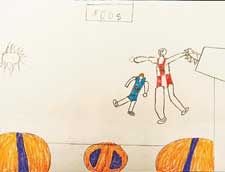 |
 |
To access those memories, the art therapist removes the need for words. By drawing or sculpting, the victim can express the trauma nonverbally and metaphorically, even if the person has no explicit memory of it, as in the case of the West African woman who was invasively searched. Moreover, expressing memories nonverbally, which is a right-brain activity, may later allow the person to recall it explicitly and talk about it, which is a left-brain activity. This integration of the two hemispheres, as well as the connection between mind and body that occurs during the act of making art, can repair the fragmentation that often follows trauma.
Creating a work of art is also empowering. Buk encourages patients to replace their identity as a victim with their role as an artist, where they have control over the outcome. This proves especially effective for survivors of abuse or torture, who've experienced helplessness and loss at the hands of others. Buk teaches art therapy students and clinicians from other disciplines to be extremely respectful of the art by keeping it safe in a patient's individual portfolio. "The art can be thought of as an extension of the artists themselves," she says.
It is clear that Buk, a deeply empathic person who sees about eight patients a day in her private practice, sometimes finds her patients' terrible stories of trauma and abuse difficult to bear. This is an occupational hazard for anyone working with trauma survivors, and Buk lectures frequently on how to cope with vicarious traumatization. But the value of her work to her patients, and the remarkable recoveries she has witnessed, far outweigh the difficulties.
"The world can be a very brutal place—but it can also be profoundly moving and beautiful," Buk says. "Learning to come to grips with that dichotomy is what life is about." 
Elaine McArdle is an award-winning journalist who writes for the Boston Globe, Boston Magazine, and other publications. She is co-writing a book about migraines with a Harvard neurologist.
|

